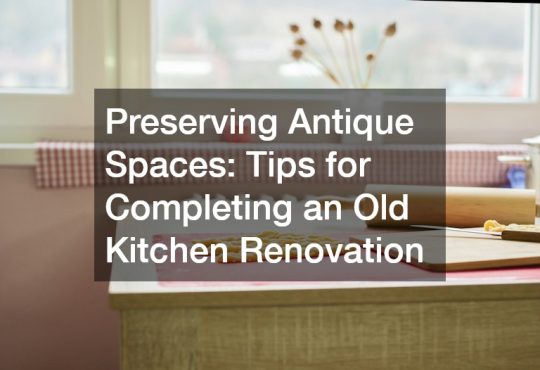
Buying a Home? Dont Miss These Details
When buying a house, especially for the first time, doing due diligence is crucial. You need to know what you’re paying for by demanding full disclosure of the state of the home. Merely looking at a home’s exterior or interior without inspecting other aspects, such as the foundation, the roofing, and other areas, won’t reflect the current state of a home. It helps to get an experienced home renovation expert to inspect a prospective home thoroughly. When you’re ready to buy a home, check the following details:
1. Check Out the Backyard

Before the COVID-2019 pandemic, having a functional backyard wasn’t a big deal. However, with the enforced lockdowns of 2020 that lasted until sometime in 2021, people were forced to work at home for months. As such, backyards became the only spaces where one could experience the outdoors. To achieve a reasonable work-life balance, homeowners need to spruce up their backyards and convert them into spaces for unwinding, work, and entertainment.
Outdoor spaces such as the backyard have long been favorites with homebuyers. Before buying a home, one of the decisions you should make is how much outdoor space you want and how you intend to use it. For instance, you may need to scout for the best patio builders if having a patio is important to you and the home you’re ready to buy doesn’t have one.
Besides adding value to your home, having a patio in your backyard extends your living space. It’s also a perfect place for unwinding, providing numerous health benefits. If the home doesn’t have a patio, you’ll have to factor in the cost of constructing one when discussing the home’s sale price.
2. Consider a Garden
If you have a green thumb, a garden is a crucial element of a home. This is where you’ll grow essential vegetables, fruits, and other plants to nourish your family. As such, if you’re ready to buy a home after saving up or securing financing, check out prospective homes with space for a small garden or at least ample space to accommodate your favorite garden plants.
One of the benefits of having a home garden is that it’s a source of organic, fresh foods, a rarity in a market dominated by GMOs and foods grown using pesticides with long-term harmful effects. A home garden lets you easily control pests, insects, and plant diseases to keep your crop healthy and fit for consumption. Besides these obvious nutritional benefits, gardening is a physically exerting activity that keeps you in great shape.
Before buying a new home, ensure it has ample space for a garden to grow some of the foods you love. If the home you plan to buy already has a garden, that’s a plus, as plants take time to mature. Besides, a garden makes your home look beautiful, especially if it has flowers that open at various times of the day and night to release beautiful scents. Taking leisurely walks in such a garden is highly therapeutic.
3. Make Sure Pests are Gone

If, after doing due diligence, you’ve settled on a home you’re ready to buy, don’t sign on the dotted line before checking if it has a pest infestation. The last thing you want is to deal with a pest infestation after moving into your new home. You want to be sure all the pests are gone by the time you move in. Establish if you’ll need to pest control termites, rodents, ants, roaches, or other pesky nuisances that could make living in your new home a nightmare.
When inspecting a home for pests, some signs you should look out for are dead bugs, evidence of nesting, noise, smell, scratch marks, stains, and holes. You should inspect the house for grease marks and trails, as pests like rodents and insects always use the same route. Other things to look out for are empty egg cases, bloodstains, shed skin, and droppings, usually left behind by pests such as rodents, cockroaches, and bedbugs.
To establish if the outdoors is pest-infested, check for damaged plants, such as gnawing on leaves, grass edges, or blades. While at it, inspect the home for breeding signs, such as the presence of anthills. The most obvious giveaway of a home that has had to contend with a pest invasion is the presence of traps and empty pesticide spray bottles. If you spot any of these signs, make a mental note to contact pest control services to get rid of the nuisance before moving in.
4. Fix Any HVAC Problems
If you’re ready to buy a new home, you must have checked its HVAC system and confirmed it’s working efficiently. Inspecting the HVAC system if the home is old is critical. You want to ensure the home has a functional, energy-efficient air conditioning system. If it’s an old model, it may result in higher-than-expected energy bills. Get the seller to replace it or factor in the cost of buying a new one in the sale price.
As you inspect the HVAC system, check and fix problems you encounter, such as air duct repair. Go into every room and pay close attention to their comfort levels. You also want full disclosure of previous repairs and maintenance. If the HVAC system has a warranty, inquire if it’s transferable to you as the new homeowner.
Understanding the home’s type of HVAC system is also crucial. Does it come with indoor air quality accessories such as a programmable thermostat? One of the things you shouldn’t ignore is the age of the HVAC system. If it’s between 10 and 15 years old, it’s at the end of its lifespan, and you should ask the seller to replace it first or deduct the cost of buying and installing one from the home’s sale price.
One last thing you should do is inspect the HVAC system visually. Look out for weird noises and anything you consider unusual. To be certain, hire an HVAC professional to inspect it.
5. Look Into Roofing and Flooring

Chances are you won’t get a complete picture of the state of a home you’re ready to buy by just looking at it. However, a quick visual scan of a roof should get you started on a home’s roofing condition. If damages to the roof are visually discernible, expect to spend on expensive repairs in the not-too-distant future.
The best way to inspect a roof is to get a professional, such as a storm damage roofer, to do it for you. They’ll spot underlying issues, such as structural problems you won’t quickly notice. Unless it’s a new home you’re buying, old homes require a thorough roof inspection, which should include the roof’s age. If it’s at least fifty years, it’s due for replacement. Other things to look for are missing or damaged shingles, mold, water damage or leaks, compromised vents, a sagging roof, poor drainage, and substandard roofing materials.
Most home buyers rarely pay attention to a home’s flooring. Unless it has dated carpets or apparent signs of disrepair, most home buyers hardly consider what’s beneath their feet when inspecting a house. Check the floor carefully by looking under the carpet to see what expensive repairs could be lurking there. Don’t assume all’s well under the carpet until you’ve checked it out.
If it’s a hardwood floor, consider the possibility of having to strip, sand, stain, or finish it, which is quite an expense. These are essential factors to consider, as repairing hardwood floors rarely reverts them to their original state. You can be sure the repaired areas will show.
6. Don’t Forget the Gutters
Being ready to buy a home means you’ve had a professional inspect it for damage and structural issues. A crucial part of a home is the gutter system. Check it to ensure it’s in good condition and is correctly installed. Without a functional gutter system, rainwater will simply run off the roof and gather at the base of your home, compromising its foundation and structural integrity. In this case, you’ll need a local gutter installation company to address the issue.
A functional gutter redirects rainwater from your roof to the drains. If the gutter isn’t functioning or there’s none, rainwater simply collects around your house. As the water flows from the base of the house to other areas on your compound, it erodes the soil, causing havoc to the landscape and ultimately compromising the integrity of your home. The result could be damage to the siding, roof leaks, mold, and wood rot, among other issues.
7. Be Prepared for Emergencies

No matter how ready to buy a home you are, things sometimes go wrong. You may have ticked all the boxes but still have to contend with emergencies. To be prepared for them, you’ll need the contacts of several service providers on speed dial. One of these is an electrician who can quickly come to your aid should there be a fault in your home’s wiring.
Wiring issues can cause extensive damage if not promptly addressed. One of the things you need is a standby generator to light your home in case of an outage. Another contact you’ll need on speed dial is that of your local plumber. Getting a plumber on site as quickly as possible is critical in a flooding emergency.
Another potential emergency is a fire breakout, in which case your new home should have the appropriate fire safety equipment. You should also have the contacts of the local fire emergency services on standby. Other potential emergencies include leaks and a malfunctioning HVAC system. While your new home may not have any issues at the moment, it’s best to prepare for the worst even if nothing happens than failing to do so and everything that could go wrong goes wrong.
8. Don’t Skip the Foundation
The foundation of a home is what keeps it standing. To keep the foundation solid, rainwater should flow away from it, which means your new home should have gutters and downspouts that direct water into the drains. Leaks can also compromise the integrity of a home’s foundation, which is why you need the services of a local waterproofing company to deal with leaks and flooding emergencies.
You aren’t ready to buy a home until a professional thoroughly inspects its foundation for potential faults. A home inspector will check your home’s foundation for any fault that could jeopardize your safety. They’ll also tell you if the home’s foundation meets the local building codes.
When inspecting your house, they’ll look for signs such as water damage, cracks, etc. They’ll inspect the walls, doorways, and floors for faults. Other areas they’d likely look into are crawl spaces and basements, as they are located under the house and, therefore, likely to show signs of damage to the foundation.
9. Consider Financing
Now that you’ve checked all the critical boxes and are ready to buy a new home, think about how you’ll finance the purchase. One option is getting a home loan from a reliable lender. You’ll be required to put down a % deposit. The higher the deposit, the better for you, as this impacts your LVR (loan-to-value ratio).
You’ll also need to be sure of your ability to pay off the home mortgage premiums. Unless you are among the lucky few who can afford a home from their savings, carefully evaluate your financing options before buying a home. You need to watch out for the interest rates, which differ from one financing option to another.
Carefully review your current and projected expenditures to understand your financial position and decide if you can afford the mortgage. A future mortgage and total debt payments shouldn’t take more than 36% of your pre-tax income. Principal.com recommends that your total monthly cost be at most 28% of your pre-tax income. If your debt exceeds these figures, consider saving up before house hunting. Ultimately, the more you save for the down payment, the more mortgage options you’ll have.
10. Don’t Forget Your Furry Friends!
If you have furry friends, consider buying a pet-friendly home. First, it should at least have a dog fence if the pet in question is a dog. Next, confirm that the home meets the local pet laws and requirements for a homeowner. Find out what types of pets and the number the prospective home can accommodate.
The house should also have easy access to pet services, such as veterinary clinics. You’ll also need to establish if the neighborhood has pet-friendly services. You can establish this by driving around and looking for a pet park, dog trails, and abundant green spaces. The layout of the home should also be pet-friendly. The goal is to ensure the house has the requisite features for a comfortable life for you and your pets. Now, you are ready to buy your new home.
Getting ready to buy a home involves doing due diligence to establish if you have access to financing facilities. Next, you’ll need to ensure the home you’re interested in meets all your requirements, such as a solid foundation and roof, a functioning HVAC system, working gutters and downspouts that direct rainwater away from your home, a perfect floor, pests-free, and pet-friendly. It should also be a well-maintained backyard with a garden for organic vegetables and fruits.



